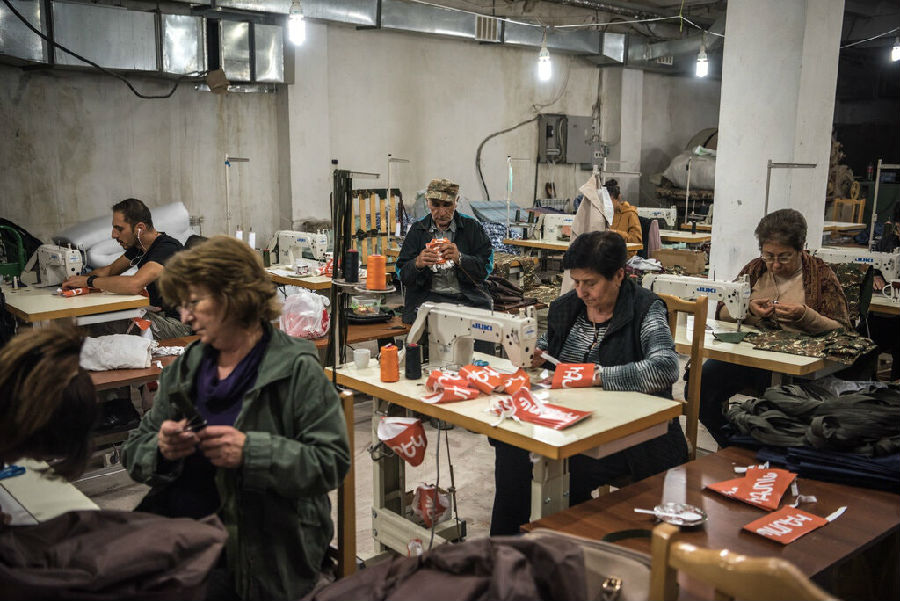On Saturday, Armenia and Azerbaijan announced they had negotiated a truce, mediated by France,
周六,亚美尼亚、阿塞拜疆宣布,他们在法国的斡旋下,通过谈判达成了休战协议,
to allow bodies to be collected and prisoners to be exchanged.
允许彼此收尸并交换囚犯。
But as with a Russian-brokered cease-fire reached a week earlier, the fighting has continued,
然而,与一周前在俄罗斯斡旋下达成的停火协议一样,谈判结束后,双方并未停止交战,
with each side accusing the other on Sunday of violating the truce.
还互相指责对方违反了停火协议。
"Their war effort against the Armenians is principally an attrition fight,"
“他们针对亚美尼亚人发动的战争其实是一场消耗战,”
Michael Kofman, a military analyst at CNA, a nonprofit research and analysis organization in Arlington, Va., said of Azerbaijan's campaign.
位于弗吉尼亚州阿灵顿的非营利性研究分析机构CNA的军事分析师迈克尔·科夫曼在谈到阿塞拜疆的行动时说道。
"It's not really well organized with a clear theory of victory."
“他们的行动并没有很好的组织性,也没有清晰的取胜方针。”
Outgunned, Armenia has thrown conscripts and volunteers into the battle.
受到火力压制的亚美尼亚已经开始将征召入伍的平民和志愿者送上战场。
Some of the latter are veterans of the 1990s war, like Artur Aleksanyan,
部分志愿者还是阿图尔·阿列克桑扬那样从90年代那场战争的前线下来的退伍军人,
a retired special forces colonel who said he was in the hospital recovering from surgery when the current conflict began.
曾任特种部队上校的阿列克桑扬说,此次冲突爆发时,他正在医院等待术后康复。
He said he now leads a volunteer unit in the trenches to the north, battling to halt the Azerbaijani advance.
据他透露,如今他正带领一支志愿部队在北部的战壕作战,努力阻止阿塞拜疆的推进。
It has been 15 years since he last wielded a weapon, Mr. Aleksanyan said Saturday in an interview in Stepanakert,
上次拿起武器已经是15年前的事了,阿列克桑扬周六在斯捷潘纳克特接受采访时说道,
where he was picking up a bag full of radio equipment before driving back to the front.
接受采访时,他正在搬一个装满无线电设备的袋子,准备开车回前线。

He lifted his uniform to show the bandages around his belly which he has to change eight times a day
他掀起制服,露出了肚子上的绷带,那是他每天都要更换八次的绷带,
and rapped his knuckles against his artificial kneecap, a reminder of his last war.
接着,他又用手指敲了敲他的假膝盖,那也是上一次战争留下的印记。
But this conflict is nothing like the 1990s, Mr. Aleksanyan said.
不过,阿列克桑扬表示,此次冲突不同于20世纪90年代的那场冲突。
Then, the Kalashnikov rifle was the principal weapon.
90年代那场冲突使用的主要武器是卡拉什尼科夫步枪。
This time, there are few exchanges of small-arms fire.
而这一次,双方几乎没有用到任何轻武器。
Of his unit's 17 days at the front, he said, 15 days were spent in the trenches,
他还说,他领导的志愿者部队守在前线的17天中,有15天都是在战壕中度过的,
taking cover from artillery barrages that came as frequently as every 20 minutes.
以躲避每隔20分钟就会出现一次的炮火袭击。
There they are surrounded by craters where Azerbaijan has been systematically destroying Armenian tanks and other equipment,
战壕四面环山,阿塞拜疆持续系统地摧毁了亚美尼亚的坦克及其他装备,
using modern "suicide drones" that loiter over a battlefield before diving down to an opportune target.
他们使用现代的“自杀式无人机”在战场上空徘徊,一发现合适的目标就俯冲下去展开袭击。
"They're so fast that we can't manage to hunt them down," Mr. Aleksanyan said.
“它们动作太快了,我们根本就没机会把它们打下来,”阿列克桑扬说。
"I won't say that we are not afraid. We are all afraid."
“我不会说我们不害怕。我们很害怕。”
Mr. Aleksanyan and other Armenian fighters said that despite Azerbaijan's fearsome firepower,
亚历克桑扬和其他亚美尼亚将士表示,虽然阿塞拜疆拥有强大的火力,
its foot soldiers proved easy targets when they tried to advance.
但事实表明,他们的步兵在推进的过程中很容易被命中。
Their bodies had not been collected, Mr. Aleksanyan said, and filled the battlefield with a putrid stench.
他们的尸体没人收走,阿列克桑扬说,战场上已经飘起来腐烂的恶臭。
译文由可可原创,仅供学习交流使用,未经许可请勿转载。













